3.14 Mapping Table Editor
The Mapping Table editor allows you to create, edit, and manage mapping table objects. A mapping table object is used by a policy to map a set of values to another set of corresponding values. After a mapping table object is created, the Map token maps the results of the specified tokens from the values specified in the mapping table.
To use a mapping table object, the following steps must be completed:
To edit a mapping table, see Editing a Mapping Table Object.
3.14.1 Creating a Mapping Table Object
A mapping table object can be created in a library, driver object, Publisher channel, or Subscriber channel.
-
In the Outline view, right-click the location to create the mapping table, then select New > Mapping Table.
-
Specify the name of the mapping table object, then click OK.
Select Open the editor after creating the object to open the Mapping Table editor.
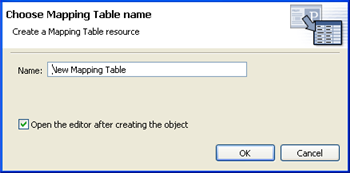
-
In the File Conflict message, click Yes to save the project before opening the Mapping Table editor.
-
In the Mapping Table editor, select column_new-1.

-
Specify a column name and data type, then click Close.
Column names must be unique. The data type lets you specify if the column values are Case Sensitive, Case Insensitive, or Numeric.
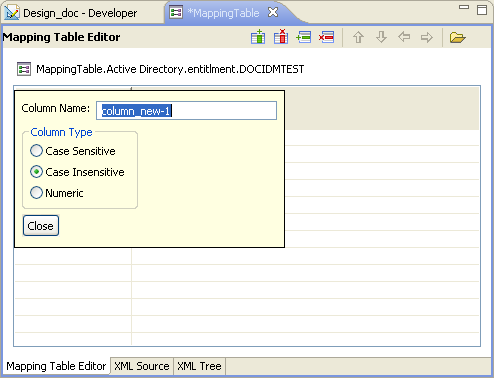
-
Select New Value to specify a cell value.
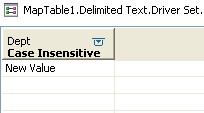
-
(Optional) To add another column, click the Add Column icon
 , then repeat Step 4 and Step 5.
, then repeat Step 4 and Step 5. -
(Optional) To add another row, click the Add Row icon
 , then repeat Step 6.
, then repeat Step 6. -
Press Ctrl+S to save the mapping table object.
-
Continue with Adding a Mapping Table Object to a Policy.
3.14.2 Adding a Mapping Table Object to a Policy
-
Either create a policy to use the mapping table in, or select an existing policy to edit.
-
Launch the Argument Builder in the Policy Builder.
For information on how to access the Argument Builder, see Launching the Argument Builder.
-
Double-click Map from the list of verbs to add it to the expression panel.
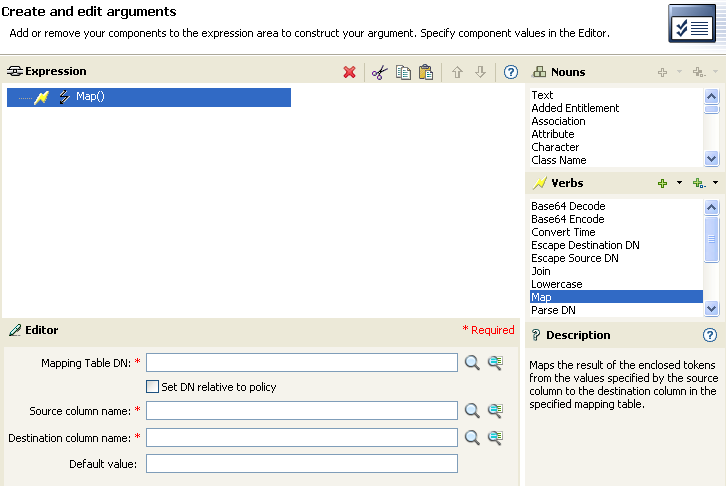
-
In the Mapping Table DN field, browse to and select the mapping table object created in Creating a Mapping Table Object, then click OK.
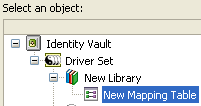
-
Select whether the mapping table DN is set relative to the policy or not.
-
Select the source column name by clicking the Browse icon.

-
Select the destination column name by clicking the Browse icon.

The mapping table can be used in any manner at this point. In this example, the OU attribute is populated with the value derived from the mapping table.

3.14.3 Editing a Mapping Table Object
Designer provides the following options to edit the mapping table:
Table 3-5 Editing Options for the Mapping Table Editor
|
Option |
Description |
|---|---|
|
|
Undoes the last action performed in the table. |
|
|
Redoes the action that was undone. |
|
|
Inserts a column to the mapping table. |
|
|
Inserts a row to the mapping table. |
|
|
Deletes a column from the mapping table. |
|
|
Deletes a row from the mapping table. |
|
|
Moves the selected row up in the mapping table. |
|
|
Moves the selected row down in the mapping table. |
|
|
Moves the selected column left in the mapping table. |
|
|
Moves the selected column right in the mapping table. |
The Mapping Table Editor also supports keyboard shortcuts for several of its operations:
Table 3-6 Keyboard Shortcuts for the Mapping Table Editor
|
Keyboard Shortcut |
Description |
|---|---|
|
Ctrl+Shift+Insert |
Insert a column to the right of the current column. |
|
Ctrl+Shift+Delete |
Delete the current column. You are prompted to confirm the deletion. |
|
Ctrl+Shift+C |
Rename the current column. Opens the Column Edit dialog box. |
|
Alt+Insert |
Insert a row below the current row. |
|
Alt+Delete |
Delete the current row. You are prompted to confirm the deletion. |
|
Ctrl+Up Arrow |
Navigate up one row. |
|
Ctrl+Down Arrow |
Navigate down one row. |
|
Ctrl+Left Arrow |
Navigate left one column. |
|
Ctrl+Right Arrow |
Navigate right one column. |
3.14.4 Importing Data from a CSV File
The Mapping Table editor allows you to import data that is stored in a CSV file. It then populates the table with the information in the CSV file. To import a CSV:
-
In an empty Mapping Table, select Import From CSV file
 .
. -
Browse to and select the CSV file, then click Open.
-
Click Yes to overwrite your existing data.
-
Press Ctrl+S to save the data in the table.
3.14.5 Exporting Data to a CSV File
The Mapping Table editor allows you to export data to a CSV file. To export data to a CSV file:
-
When the data in the Mapping Table is ready to export, select Export To CSV File
 .
. -
Click Yes to save this editor’s changes and continue.
-
Specify a name and location for the CSV file, then click Save.
3.14.6 Testing a Mapping Table Object
You can use the Policy Simulator to test the functionality of the mapping table. The Policy Simulator tests the mapping table by testing the policy that is using the mapping table. For more information, see Section 8.0, Testing Policies with the Policy Simulator.